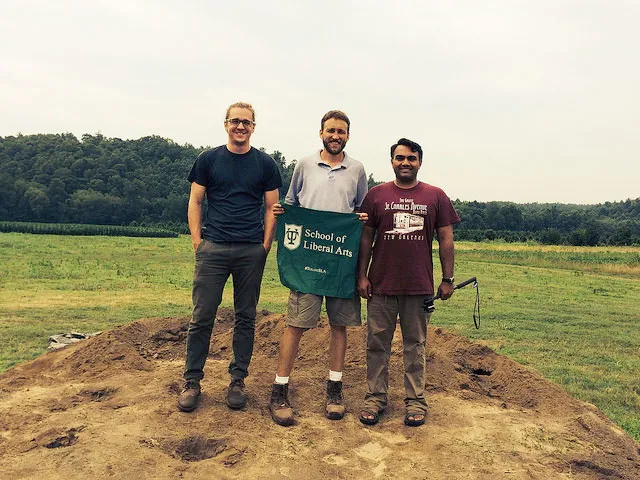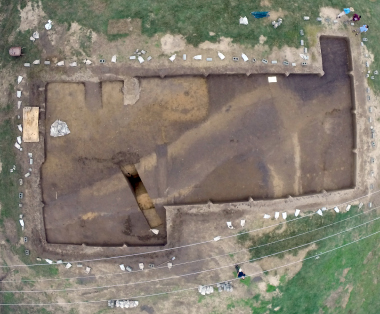
From 1566 through 1568, the northern edge of the Spanish colonial province of La Florida was situated in what is now western North Carolina. The principal Spanish outpost in the northern borderlands of La Florida was Fort San Juan and the adjacent colonial town of Cuenca, both of which were located at the edge of the Native American town of Joara. The fort was attacked by warriors from Joara in 1568, and it and five other Spanish forts in the Carolinas and eastern Tennessee were abandoned. At that point, the focus on Spanish colonialism in La Florida shifted from military exploration and installation to missionization and trade. My archaeological investigations since 2001 with collaborators and project codirectors—David Moore (Warren Wilson College) and Rob Beck (University of Michigan)—at the Berry site in western North Carolina have unearthed remnants of Joara, Cuenca, and Fort San Juan. The fort itself was rediscovered in 2013, and excavations in 2014 have shed light on the shape and size of the earthen ditch enclosing the fort itself, and the surprisingly substantial architectural footprint of this short-lived monument to sixteenth-century Spanish colonial ambition and imperialism in the American South. This longstanding archaeological research project has received funding from several sources, including the National Science Foundation (NSF), the National Geographic Society (NGS), and local government agencies and historical societies. The School of Liberal Arts, the SLA Graduate Merit Summer Fellowship Program (grant to Merritt Eller, M.A. 2009), the Department of Anthropology, the Center for Archaeology, the Committee on Research, and the Research Enhancement Fund at Tulane University have contributed to this project through funding and other forms of support.
An expedition led by the Spanish conquistador, Hernando de Soto, traversed the Native American province of Xuala, in the upper Catawba River Valley of western North Carolina, in 1540. The Soto expedition briefly visited the town of Xuala and then crossed the Appalachians, en route to Native American towns along the upper reaches of the Tennessee River. Written accounts of the Soto expedition describe Xuala as a prosperous province. The Soto expedition reached the Mississippi River in 1541, and surviving members traveled by boat to the mouth of the Mississippi in 1543.

One generation later, in 1566, an expedition led by Captain Juan Pardo marched inland from the Spanish colonial capital at Santa Elena, in coastal South Carolina. Pedro Menendez de Avilés, the admiral of the Spanish colonial fleet in the Caribbean and the aspiring colonial governor of La Florida, charged Pardo with the tasks of establishing permanent towns along an overland route connecting Santa Elena with New Spain and the Spanish silver mines near Zacatecas, Mexico, making alliances with native groups between Santa Elena and New Spain, and evangelizing them. Pardo and his men marched north and west from Santa Elena following Native American trails leading them to native towns where they could find food, and they visited many of the same towns in the Carolinas and eastern Tennessee that Soto had visited 26 years before. Pardo gave gifts to chiefs at the Native American town of Joara—the same town as the Xuala in the accounts of the Soto expedition—and the people of Joara set aside food and built houses for Pardo and his men. Because of the power and prosperity of the town of Joara, because of the favorable farmland in surrounding areas, and because snowcapped mountain peaks visible from Joara discouraged further travel, Pardo chose the town of Joara as the location of his primary outpost, which he named Cuenca, after his hometown near Seville, Spain, and where he and his men built Fort San Juan. The favorable diplomatic relations between Pardo and Joara soured in 1567, and in the spring of 1568, news reached the Spanish colonial capital at Santa Elena that Fort San Juan and Pardo’s five other forts had been attacked by Native American warriors, and had been abandoned.
Written records chronicle some of the major events that took place at Cuenca and Fort San Juan, but they do not record much about daily life at this colonial outpost at the edge of La Florida, nor do they record much about entanglements between the native people of Joara and other towns and Spanish colonists. Archaeological finds at the Berry site demonstrate the significance of Native American foods, material culture, and architecture to the Spanish colonial presence at Cuenca. Recent finds from Fort San Juan itself indicate that it resembled the Spanish fort that Pardo and his men had built at Santa Elena in 1566 before they marched inland to the town of Joara. Always in short supply, Spanish material culture was often recycled, and many colonial goods were given as gifts or traded to the people of Joara—including the metal knives that Pardo gave the chief of Joara in 1568—until the stream of such gifts from Santa Elena ran dry. Given the width and depth of the ditch that enclosed the fort, the earthen embankments along the outer edges of the fort, and the placement of the fort within the local landscape, it is evident that the colonists at Fort San Juan considered themselves vulnerable, despite Pardo’s strategic emphasis on diplomacy rather than force. Further fieldwork at Berry will concentrate on the characteristics of Fort San Juan, and the spatial and temporal relationships between the fort and Native American structures nearby. The built environment of Joara, Cuenca, and Fort San Juan form an architecture of contact, through which complicated relationships between natives and newcomers were negotiated and navigated.
We presented papers at the annual Southeastern Archaeological Conference and the annual conference of the Society for American Archaeology in 2014, and have recently completed a book manuscript about recent finds at the Berry site. This manuscript, The Limits of Empire: Colonialism and Household Practice at the Berry Site, 1566–1568, has been accepted for publication by the University Press of Florida, with an anticipated publication date of 2016. They recently published a chapter in a scholarly volume, Native and Spanish New Worlds: Sixteenth-Century Entradas in the American Southwest and Southeast, edited by Clay Mathers, Jeff Mitchem, and Charles Haecker, published by the University of Arizona Press in 2013, including papers about Native American encounters and entanglements with Spanish conquistadores and colonists in New Spain and in La Florida. Meanwhile, other papers for academic publications are in preparation. Collectively, these and other publications contribute to archaeological knowledge of culture contact and colonialism, and the ways that Native Americans actively shaped the course of European colonial history in the New World.
Archaeological investigations at the Berry site have been sponsored by Warren Wilson College (Asheville, North Carolina), Western Piedmont Community College (Morganton, North Carolina), the University of Michigan, the University of Oklahoma, and Tulane University. This project spawned the not-for-profit Exploring Joara Foundation, which was formed in 2008, which promotes public outreach and public education in archaeology, and which hosts public events throughout the year, including workshops and site visits by groups of students and schoolteachers. EJF received the annual Excavation Outreach Award from the Archaeological Institute of America in 2013.
Recent news coverage about archaeology at the Berry site includes the following:
Discover Magazine, January/February 2014
Top 100 Stories of 2013, #29: Lost Spanish Fort Finally Revealed
Carolina Arts and Sciences Magazine, 9/13/2013
“Exploring Joara: Excavating the Past, Shaping the Future in Western North Carolina”
Archaeology Magazine [Online News], 7/24/2013
“Earliest European Interior Fort Uncovered in North Carolina”
New York Times, 7/23/2013
“Fort Tells of Spain’s Early Ambitions”
Archaeology Magazine, July/August 2009
“Spain’s Appalachian Outpost”

